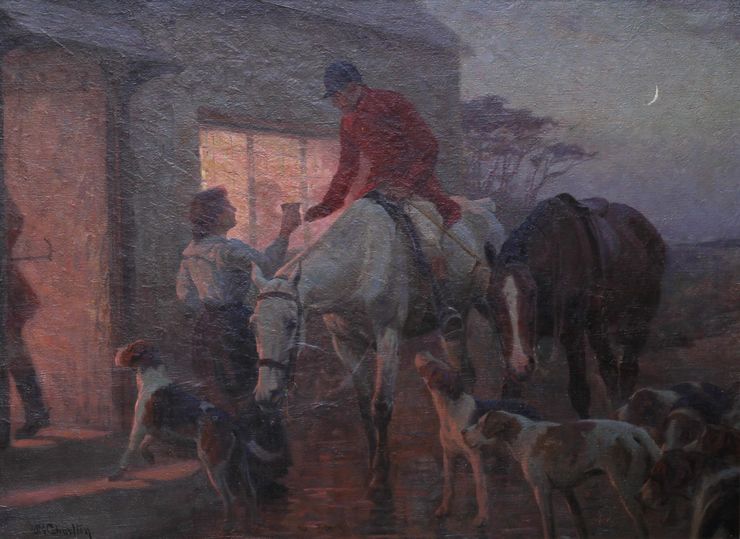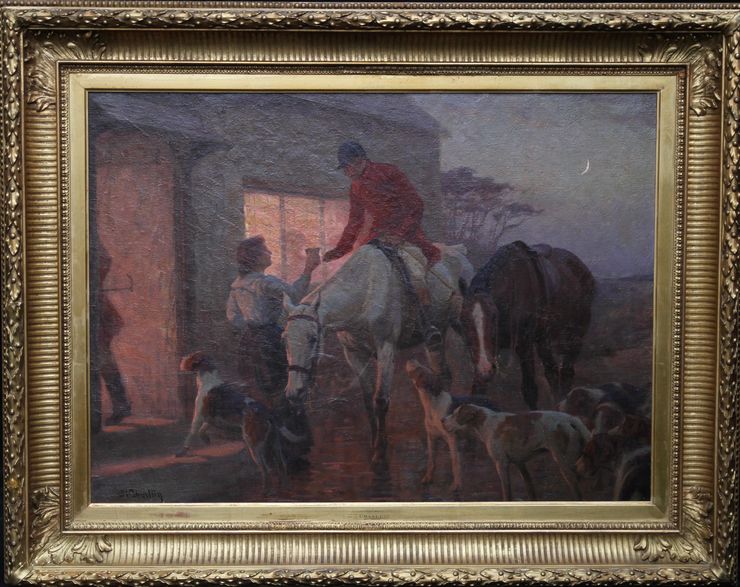John Charlton (1849-1917)
| Artist Name | John Charlton (1849-1917) |
|---|---|
| Title | The end of the day |
| Description | A large fine oil on canvas which dates to circa 1900 by noted British artist John Charlton. This is one of the best large romantic works that I have seen by this artist. It depicts The End of the Day for a huntsman and his hounds as they stop for a drink under the glowing evening of a cresupular moon. A stunning painting. Signed lower left. |
| Provenance | Christies London |
| Medium | Oil on Canvas |
| Size | 31.9 x 25.2 inches |
| Frame | Framed in a fine gallery frame 41 inches by 34 inches |
| Condition | Excellent condition |
| Biography | John Charlton (1849-1917). Charlton was a very successful British artist known for his powerful military scenes, detailed and accurate animal and figure paintings, and vivid landscapes. He debuted at the Royal Academy in 1870 and exhibited there until 1904, contributing 53 works. He was born in North East England and received his first drawing lessons from his father. Due to his family’s financial misfortunes, Charlton was enrolled in Dr. Sharp’s charity school, but a short time later was forced to quit and find employment. His first job was at a bookstore, which gave the promising artist a chance to copy the master’s work. Years later, while working as a draughtsman, his employers noticed his extraordinary talent and regularly granted him time to practice his art. At the suggestion of Mr. Joseph Crawhill, a notable British illustrator, Charlton began to attend evening classes at the Newcastle School of Arts under William Bell Scott. It was during this time that Charlton developed a reputation as a skilled painter of horses and dogs, and began receiving commissions to portray family pets. In 1874, realizing that his best chance for advancement lay in the London art world, he ventured south and took classes at the South Kensington Museum, now the Victoria and Albert Museum. To earn a living, Charlton became an illustrator for The Graphic, and his sketches of the Egyptian Campaign of 1882 were often reproduced in the popular weekly illustrated British newspaper. Experiencing the wealth of military illustration, he decided to try his hand at creating a large war-themed painting, and in 1883 exhibited British Artillery Entering the Enemy’s Lines at Tel-el-Kebir, 13 September 1882. The critics praised the canvas calling it a “vigorous and vividly realistic rendering.” Spurred on by the success, he chose another military scene for his 1887 academy piece. Based on a sketch by a Royal Navy surgeon, Charlton painted Bad News from the Front, a scene from the Suakim campaign of 1885. For his 1893 piece, Placing the Guns, he returned to the Sudan campaign. His next military subject was from the Zulu War, After the Charge: 17th Lancers, Ulundi, 4 July 1879, which was shown at Burlington House in 1888. Charlton exhibited several paintings from the Crimean War, including An Incident in the Charge of the Light Brigade, shown at the academy in 1889. In 1897 he exhibited another powerful piece called Comrades, showing a trooper of the 17th Lancers lying dead on the field while his horse, hit by a bullet, rears in agony. The artist’s success continued, and in 1905 his picture Balaclava: The Charge of the Light Brigade was reproduced in the Christmas Supplement to The Graphic. Charlton also painted scenes from the Peninsular War and the English Civil War, and occasionally turned to foreign wars not involving Britain. In After the Battle: Sedan, based on an incident in the Franco-Prussian War of 1870, Charlton chose one of his favorite themes, that of riderless horses after a battle. His painting of Prussian General Seidlitz at the Battle of Rossbach in 1757 was shown at the Berlin Art Gallery in April 1914 and attracted the attention of a wealthy German who offered to buy the piece, but before the sale could be finalized, war broke out and the picture was ‘interned’ in Germany. In 1916, World War One brought the pain and suffering of war directly home to Charlton. On June 24, his eldest son, Lieutenant Hugh Vaughan Charlton, was killed on the Western Front and seven days later his youngest son, Captain John Macfarlane Charlton, was killed on his 21st birthday. Devastated by his loss, the artist painted a poignant canvas, now lost, of his two sons with their grandmother; and in another painting he showed the two handsome and promising young men with their three dogs. |
| Price | SOLD |

